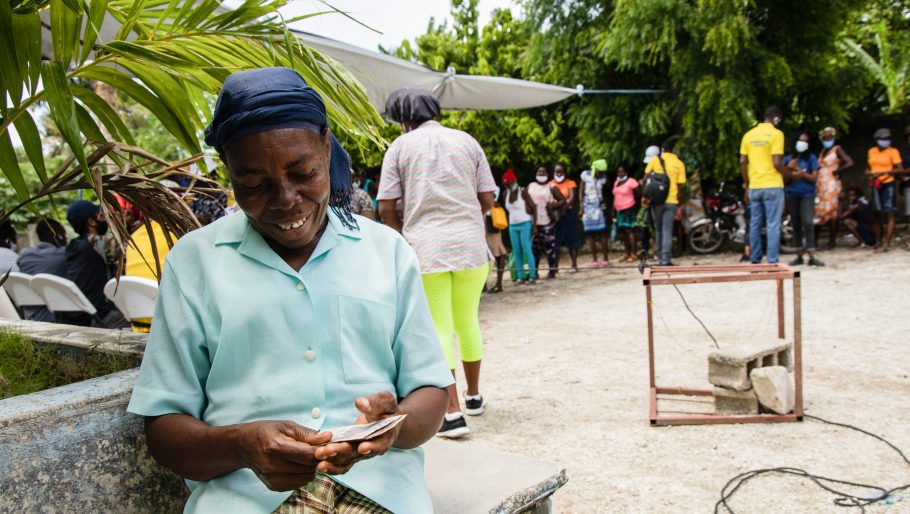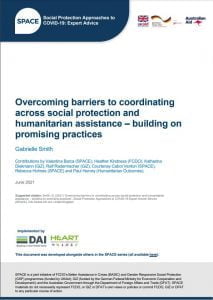Getting CVA right in the Humanitarian Response Plan: Blind Spots and Considerations

CVA & Recent HPC Adaptations
While there are conflicting opinions about the extent to which the HPC helps build a more effective response, important revisions have been made in recent years to make the tool better suited for the job – the latest being the introduction of the Joint Intersectoral Analysis. This change seeks to shift planning from sectorial silos with a fragmented view of humanitarian needs to more joined up working that considers needs holistically. The change, applauded by stakeholders in humanitarian circles, provides an opportunity to better anchor multi-sector responses – including multipurpose cash assistance (MPC) – in the planning process.
CVA forms a significant proportion of most humanitarian responses, accounting for 19% of all international humanitarian assistance in 2020. While currently available data does not allow us to consistently disaggregate MPC and sector specific CVA, we know that more sectors are using CVA to deliver assistance and, at the same time, the use of MPC is growing.
Following the introduction of a dedicated chapter on MPC two years ago, Cash Working Groups (CWGs) across the world have stepped up to play a more active role in the development of HRPs. Last year, 20 out of 27 HRPs included a MPC chapter. As we celebrate this progress, we now need to ensure that the integration of MPC results in high quality HRPs that meet their planning objectives. Some points to consider:
Be systematic: Consider all sections of the HRP
- Consider all response modality options in all the sections of the HRP – this will help ensure CVA is used where and when appropriate and feasible.
- Involve CVA experts throughout the planning process to ensure context-specific considerations.
- Ensure CWGs are represented in inter-cluster mechanisms established to carry out inter-sectoral analysis.
- Include a separate chapter for MPC, with an analysis of its relevance in the response.
There is so much that can be included in the HRP. Three critical points from CVA perspective are:
1. Markets & Financial Service Providers
- Consider market support interventions, if markets appear to be failing
- Understand and ensure plans consider the preferences and financial literacy of different communities
- Include an assessment of financial services providers
- Consider the risks of each modality and delivery mechanisms for different communities
2. Gender
- Consider the intersections between CVA and gender. CARE’s work on Gender sensitive CVA provides guidance on gender-specific needs, risks and concerns and how to incorporate mitigating measures into the response
- Analyse data on access to markets, financial decision making, and financial service provider (FSP) preferences – considering the needs of different population groups

3. Cohesion and Synergy across sectors
- Agree a shared approach to generating a robust analysis of the use of CVA between sectors and exploring potential linkages.
- Set aside the time for collaborative work to enhance the quality of cross-sectoral considerations and outcomes. Consider, for example, how does MPC and CVA for different sector-specific outcomes overlay where the same populations are targeted? Do the different sectoral CVA activities align and complement each other? How will the clusters and CWG work together to facilitate cohesion across the CVA interventions?
Looking Beyond Humanitarian Responses – Linking with National Social Assistance
It’s also important to consider the complementarities between CVA and other forms of assistance.
The need for better coordination and collaboration between humanitarian action and social protection mechanisms has been voiced by many actors and is now widely accepted as a principle of quality people-centered aid. There is growing consensus that linkages and/or alignment between humanitarian CVA and national social assistance programmes could improve the impact and coherence of responses, where appropriate and where conditions allow for it. Decisions on whether to link or not – or the extent to which to link – must be undertaken with clear understanding of the political dynamics and take into account the need to adhere to Humanitarian Principles and Do No Harm.
The HPC process presents a strategic space for meaningful sector-wide dialogue, action and greater accountability on efforts to link humanitarian CVA and social protection. Indeed, this approach would be one step towards addressing some of the limitations mentioned in the SPACE paper on ‘Overcoming barriers to coordinating across social protection and humanitarian assistance’

So how can meaningful steps be taken towards integrating CVA and social protection linkages within the HRPs? Clearly, it’s not a one-size-fits-all conversation and guidance is limited.
Some avenues to consider:
- Undertake a robust analysis of the options for coordinating Humanitarian CVA with social assistance – a first step towards increasing alignment and exploring the complementarities that exist.
- Map existing social cash transfer interventions and possible points of convergence with humanitarian CVA. This document on Connecting Humanitarian CVA with Government Social Safety Nets provides guidance on how to go about this.
- Complete a political analysis to determine the most appropriate strategic approach to linking humanitarian cash assistance with social assistance programmes.
- Determine practical activities to be undertaken to promote closer collaboration between humanitarian and development actors during implementation and monitor progress.
Final Reflections
Broadly speaking, quality responses have two essential characteristics (a) they are people-centered and mindful of the all the experiences people will go through as they receive support and (b) they seek complementarities with other aid and support mechanisms. Embracing these principles within all aspects of the HRP, notably in relation to integration of CVA will no doubt enrich the analysis and response.
In the main image: Marila Zaphir receives her cash allocation from WFP. WFP is continuing to provide cash assistance to those who were enrolled
to the Cash Based Transfers programme before the earthquake in Haiti.
© WFP/Marianela Gonzalez. September 2021.


